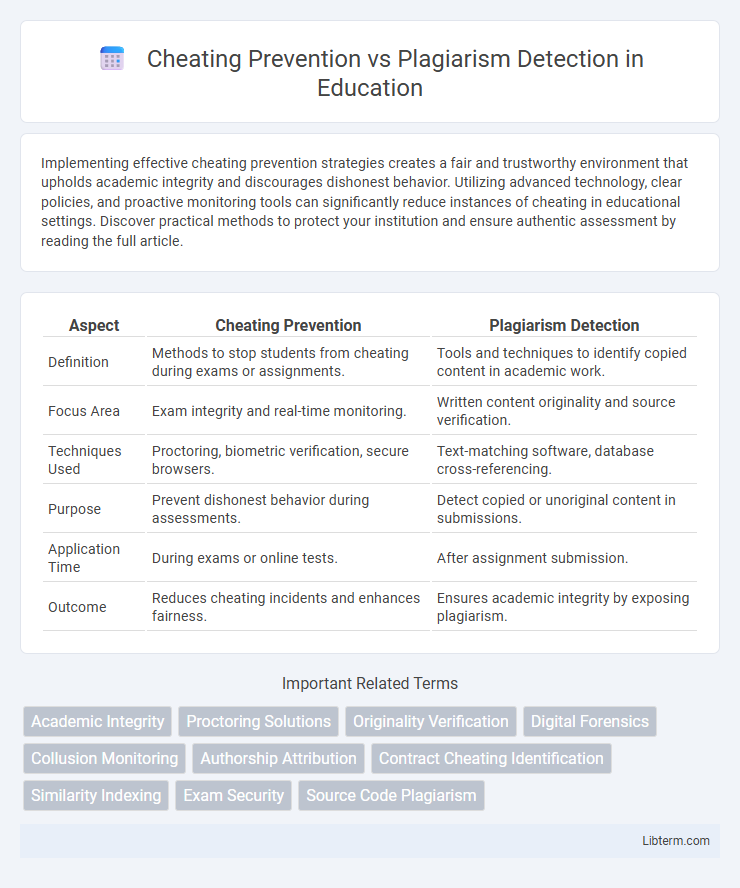Implementing effective cheating prevention strategies creates a fair and trustworthy environment that upholds academic integrity and discourages dishonest behavior. Utilizing advanced technology, clear policies, and proactive monitoring tools can significantly reduce instances of cheating in educational settings. Discover practical methods to protect your institution and ensure authentic assessment by reading the full article.
Table of Comparison
| Aspect | Cheating Prevention | Plagiarism Detection |
|---|---|---|
| Definition | Methods to stop students from cheating during exams or assignments. | Tools and techniques to identify copied content in academic work. |
| Focus Area | Exam integrity and real-time monitoring. | Written content originality and source verification. |
| Techniques Used | Proctoring, biometric verification, secure browsers. | Text-matching software, database cross-referencing. |
| Purpose | Prevent dishonest behavior during assessments. | Detect copied or unoriginal content in submissions. |
| Application Time | During exams or online tests. | After assignment submission. |
| Outcome | Reduces cheating incidents and enhances fairness. | Ensures academic integrity by exposing plagiarism. |
Understanding Cheating and Plagiarism
Understanding cheating involves recognizing deliberate actions aimed at gaining unfair academic advantage, such as unauthorized collaboration or copying during exams, whereas plagiarism specifically refers to presenting someone else's work or ideas as one's own without proper attribution. Effective cheating prevention requires holistic strategies, including fostering academic integrity and designing assessments that minimize opportunities for dishonesty. Plagiarism detection relies on advanced software algorithms that compare submitted content against extensive databases to identify unoriginal material, thereby supporting academic honesty and proper citation practices.
Key Differences: Cheating Prevention vs Plagiarism Detection
Cheating prevention involves implementing strategies and tools aimed at stopping dishonest behavior before or during assessments, including secure exam environments and proctoring software. Plagiarism detection focuses on identifying instances where someone has copied or improperly cited existing content, using specialized software to compare submitted work with databases and online sources. Key differences lie in their approach: cheating prevention is proactive and behavioral, while plagiarism detection is reactive and content-based.
The Importance of Academic Integrity
Cheating prevention strategies and plagiarism detection tools are essential components in upholding academic integrity, ensuring fair evaluation and trustworthiness of educational institutions. Effective implementation of these methods reduces dishonest behavior by promoting original work and accountability among students. Maintaining academic integrity fosters a culture of honesty, enhances learning outcomes, and preserves the value of academic credentials.
Methods for Cheating Prevention in Education
Methods for cheating prevention in education include implementing honor codes, using randomized test questions, and leveraging secure proctoring technologies such as AI-based monitoring and biometric verification. These strategies focus on creating a culture of academic integrity, reducing opportunities for dishonest behavior, and ensuring exam authenticity through real-time supervision. Incorporating plagiarism detection software complements prevention by identifying unoriginal content but primarily addresses consequences rather than proactive deterrence.
Effective Plagiarism Detection Tools and Techniques
Effective plagiarism detection tools utilize advanced algorithms such as machine learning and natural language processing to accurately identify copied content across vast databases, including academic papers, websites, and publications. Techniques like text matching, citation analysis, and semantic similarity evaluation enhance detection accuracy by distinguishing between properly cited sources and unethical copying. Leading platforms such as Turnitin, Grammarly, and Copyscape offer comprehensive reports, real-time scanning, and integration with learning management systems for streamlined plagiarism prevention and academic integrity enforcement.
Integrating Technology in Maintaining Authenticity
Integrating technology in maintaining authenticity leverages advanced cheating prevention tools such as secure browsers and biometric authentication to create a controlled assessment environment. Plagiarism detection software employs sophisticated algorithms that compare submissions against vast databases, identifying unoriginal content with high accuracy. Combining these technologies ensures comprehensive academic integrity by addressing both unauthorized assistance and content originality.
Benefits of a Proactive Cheating Prevention Approach
A proactive cheating prevention approach enhances academic integrity by identifying and addressing potential dishonest behaviors before they occur, reducing the incidence of violations. Unlike plagiarism detection, which only recognizes copied content after submission, proactive methods foster a culture of honesty through real-time monitoring and student engagement. Implementing prevention strategies leads to improved learning outcomes, as students are encouraged to develop original work and critical thinking skills.
Limitations of Relying Solely on Plagiarism Detection
Plagiarism detection tools primarily identify copied content but often fail to detect deeper forms of academic dishonesty such as contract cheating or idea theft. These tools rely heavily on existing databases and cannot recognize original work disguised through paraphrasing or translated content. Effective cheating prevention requires a comprehensive approach including exam proctoring, behavioral analysis, and fostering academic integrity culture beyond just plagiarism detection software.
Creating a Culture of Honesty in Academia
Creating a culture of honesty in academia relies more on cheating prevention strategies than solely on plagiarism detection tools, emphasizing proactive education, clear policies, and ethical leadership. Encouraging integrity through honor codes, open discussions about academic ethics, and fostering transparent assessment methods reduces the motivation to cheat or plagiarize. Institutions like Harvard University and Stanford have demonstrated that integrating these preventive measures cultivates a respectful learning environment and sustains academic credibility.
Future Trends in Academic Integrity Solutions
Future trends in academic integrity solutions emphasize advanced cheating prevention methods leveraging AI-driven proctoring and biometric authentication to ensure real-time monitoring and identity verification. Plagiarism detection tools are evolving with natural language processing capabilities to identify sophisticated paraphrasing and source manipulation beyond simple text matching. Integration of blockchain technology for immutable record-keeping and collaborative platforms promoting original work creation further enhance the landscape of academic honesty enforcement.
Cheating Prevention Infographic

 libterm.com
libterm.com